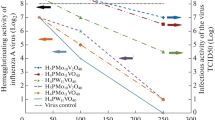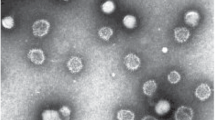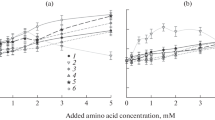Abstract
Hen egg-white lysozyme and three of its basic derivatives obtained by chemical modification were tested for their activity in vitro against a wild strain of herpes simplex virus type 1. Marked inhibition of the cytopathic effect was exhibited by the three chemical derivatives and the heat-inactivated lysozyme, whereas the native enzyme displayed only modest anticytopathic activity. Enzymatic activity did not appear to be necessary for the antiherpes activity of the lysozyme compounds. Instead, other properties such as their basic nature seemed to be relevant to their antiherpes effectiveness in vitro. At the concentrations used, all compounds but one had no significant effect on cell viability and growth. Some of the compounds tested caused formation of deposits on the surface of the cells. Some correlation between deposit formation and antiherpes cytopathic activity was found. The antiherpes efficacy in vitro and toxicity of the modified lysozymes were compared with those of known antiviral agents. The lysozymes were less toxic than the reference antiviral agents, and some of them were also more active.
Similar content being viewed by others
Literature Cited
Asdourian, H., Chu, L., Lau, K., Amos, H. 1975. Lysozyme: Evidence for effects on chick fibroblasts, HeLa cells, and their products. Biochemical and Biophysical Research Communications64:1142–1151.
Burnet, F. M., Lush, D., Jackson, A. V. 1939. A virusinactivating agent from human nasal secretion. British Journal of Experimental Pathology20:377–401.
Chang, T. W., Weinstein, L. 1973. Antiviral activity of isoprinosine in vitro and in vivo. American Journal of the Medical Sciences265:143–146.
Ebbesen, P., Ablashi, D., Vestergaard, B. F., Easton, J., Hesse, J., Armstrong, G. 1979. Inhibition of herpes simplex virus and herpes-virus Saimiri with polyions. Microbiologica2:191–195.
Fleming, A. 1922. On a remarkable bacteriolytic element found in tissues and secretions. Proceedings of the Royal Society of London B93:306–317.
Gordon, P., Ronsen, B., Brown, E. R. 1974. Anti-herpes action of isoprinosine. Antimicrobial Agents and Chemotherapy5:153–160.
Helgstrand, E., Eriksson, B., Johansson, N. G., Lannerö, B., Larsson, A., Misiorny, A., Norén, J. O., Sjöberg, B., Stenberg, K., Stening, G., Stridh, S., Öberg, B., Alenius, S., Philipson, L. 1978. Trisodium phosphonoformate, a new antiviral compound. Science201:819–821.
Orzalesi, F. 1953. Primi tentativi di terapia di cheratiti conlisozima. Giornale Italiano di Oftalmologia6:210–216.
Orzalesi, F., Miglior, M. 1952. Neutralization “in vitro” du virus herpétique par le lysozyme. Bulletin et Mémoires de la Société Française d'Ophthalmologie65:433–437.
Pompei, R., Flore, O., Marcialis, M. A., Pani, A., Loddo, B. 1979. Glycyrrhizic acid inhibits virus growth and inactivates virus particles. Nature281:689–690.
Rawls, W. E. 1980. Herpes simplex viruses, pp. 783–789. In: Lennette, E. H., Balows, A., Hausler, W. J., Jr., Truant, J. P. (eds.), Manual of clinical microbiology. Washington, DC: American Society for Microbiology.
Reno, J. M., Lee, L. F., Boezi, J. A. 1978. Inhibition of herpesvirus replication and herpesvirus-induced deoxyribonucleic acid polymerase by phosphonoformate. Antimicrobial Agents and Chemotherapy13:188–192.
Scheidegger, E. 1940. Experimentelle Untersuchungen über die Wirkung von Lysozym auf Menschen und Tierpathogene Virus-Arten. Archiv für die Gesamte Virusforschung1:394–403.
Takemoto, K. K., Fabisch, P. 1964. Inhibition of herpes simplex virus by natural and synthetic acid polysaccharides. Proceedings of the Society for Experimental Biology and Medicine116:140–144.
Valisena, S., Varaldo, P. E., Satta, G. 1982. Purification and characterization of three separate bacteriolytic enzymes excreted byStaphylococcus aureus, Staphylococcus simulans, andStaphylococcus saprophyticus. Journal of Bacteriology151:636–647.
Verdi, G. P., Serra, C. 1959. Ricerche sulla inibizione della attività citopatogena del virus erpetico in colture di tessuto con eparina, lisozima e protamina. Annali Sclavo1:175–196.
Author information
Authors and Affiliations
Rights and permissions
About this article
Cite this article
Cisani, G., Varaldo, P.E., Ingianni, A. et al. Inhibition of herpes simplex virus-induced cytopathic effect by modified hen egg-white lysozymes. Current Microbiology 10, 35–40 (1984). https://doi.org/10.1007/BF01576045
Issue Date:
DOI: https://doi.org/10.1007/BF01576045




